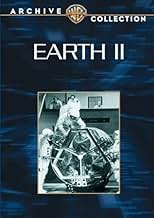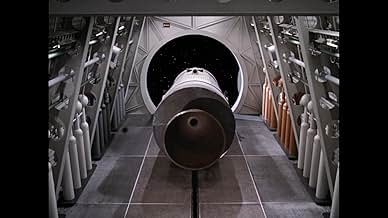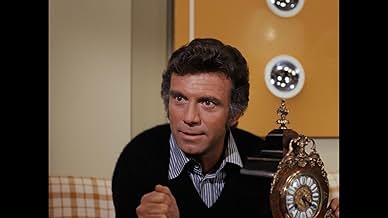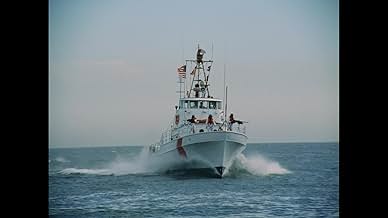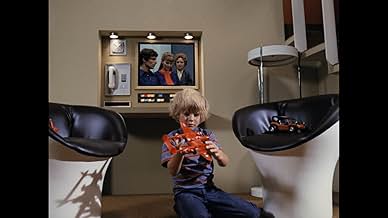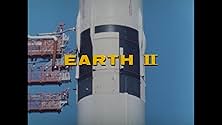Agrega una trama en tu idiomaWhen Earth II, an orbiting research space station, is menaced by a Red Chinese nuclear weapon, its 2,000 inhabitants take action to disarm and dispose of the missile without resorting to vio... Leer todoWhen Earth II, an orbiting research space station, is menaced by a Red Chinese nuclear weapon, its 2,000 inhabitants take action to disarm and dispose of the missile without resorting to violence.When Earth II, an orbiting research space station, is menaced by a Red Chinese nuclear weapon, its 2,000 inhabitants take action to disarm and dispose of the missile without resorting to violence.
- Dirección
- Guionistas
- Elenco
Anthony Franciosa
- Frank Karger
- (as Tony Franciosa)
Edward Michael Bell
- Anton Kovalefskii
- (as Edward Bell)
- Dirección
- Guionistas
- Todo el elenco y el equipo
- Producción, taquilla y más en IMDbPro
Opiniones destacadas
This is a very rare made for TV movie with a great story and excellent special effects. The only thing that might be considered wrong about this film is that even though it is supposedly set in the future, this film is now very much dated. This film was made during the height of the Cold War and at a time relations between The U.S., the then Soviet Union and China were not very good. In fact, the U.S. is almost looked at as a pawn in the struggle between the other two super powers. However, this film does provide a good glimpse at the future and how space travel could eventually be routine and the possibilities of global cooperation in outer space.
Earth II was a very earnest attempt at serious science fiction, a decided rarity in the early 1970s. It dealt with the establishment of the first orbital space colony in an unspecified year. Today, 28 years later, it's interesting to see many of the ideas represented here creeping toward reality. Only now is the International Space Station being constructed, and it bears a passing resemblance to the fictional Earth II. Both are designed to be independent of any one nation. There's a mention of a Mars mission under construction at E-II, much as today's planners say the ISS is essential to a manned mission to Mars. The early lifting-body shuttle of E-II is finally being realized in the X-33 and the VentureStar spacecraft.
Scientific jargon abounds in this picture, and it's to the movie's credit that it's more often than not used properly rather than as technobabble. The writers, with help from technical advisors and NASA, were respectful of the science -- an extraordinary step for SF movies, especially on television. This is a thinking person's science fiction, with complex situations and human interactions rather than space battles, bumpy-headed aliens, ray guns, post- apocalyptic mutants and the like.
The inspiration and influences of "2001: A Space Odyssey," two years previous, are obvious. First and foremost was the presence of Gary Lockwood, who played Frank Poole in 2001. There's also the reverence of the spaceflight sequences that bear a striking resemblance to their predecessors. Contemporary orchestral music takes the place of classical music from the masters, still trying hard to show the majesty and reality of space. The first third of the movie is spent introducing the wonders of living in this new environment with its unfamiliar physical conditions and a unique social structure very much a product of idealistic 1960s egalitarianism. Adult residents of Earth II were mandated to "attend" all important community functions via TV, and any inaccuracies and unsupported opinions on both sides of the debate were instantly pointed out by on-screen captions. If only today's voters could be as well-informed and responsible.
Where this movie founders somewhat is in its pacing. Sometimes it can be tough slogging, seeming quite a bit longer than its 1:45 running time. It's talky at times, even preachy in spots. A saving grace is that, despite the inescapable aging of much of the technology, the production design holds up remarkably well. There are a few set pieces that are blatantly '70s, but more that would still look good today.
One big, unnecessary dramatic device: If they needed to keep the launch bay out of the sun, why send a tug out to stop the rotation of Earth II? It would have been easier to park the tug in front of the missing hatch, providing shade for the bay, just as the real-life Skylab astronauts rigged a "parasol" to keep their workshop cool after it lost its meteoroid shield on launch.
That this movie was as well-crafted as it was despite notable flaws is a reflection on the crew. Many were involved with "Mission: Impossible," including the producers/writers, cinematographer, and composer Lalo Shifrin. The M:I connection also explains the backdrop of political tension as they tried to deal with an orbital nuclear weapon launched by a rogue nation. This is the movie's one glaring anachronism: Communist China was the nation, unaffiliated with the United Nations, that launched the weapon. It was terrible timing that after the movie was finished but only a month before it was aired, the UN adopted Resolution 2758, which stripped Taiwan of its membership and gave its seat to China. By 1979, the US had followed suit, recognizing China and leaving Taiwan in the diplomatic limbo in which it has existed ever since. There was no way to fix this problem before the movie aired. They needed a nuclear nation unconstrained by international agreements, and China was the last such candidate for the role at the time.
From the credits listing "guest stars" and "special guest star," it's clear that this was intended to be the pilot for an ongoing series. Too bad it was never to be. Now we can only guess at what heights this intriguing concept might have reached.
Scientific jargon abounds in this picture, and it's to the movie's credit that it's more often than not used properly rather than as technobabble. The writers, with help from technical advisors and NASA, were respectful of the science -- an extraordinary step for SF movies, especially on television. This is a thinking person's science fiction, with complex situations and human interactions rather than space battles, bumpy-headed aliens, ray guns, post- apocalyptic mutants and the like.
The inspiration and influences of "2001: A Space Odyssey," two years previous, are obvious. First and foremost was the presence of Gary Lockwood, who played Frank Poole in 2001. There's also the reverence of the spaceflight sequences that bear a striking resemblance to their predecessors. Contemporary orchestral music takes the place of classical music from the masters, still trying hard to show the majesty and reality of space. The first third of the movie is spent introducing the wonders of living in this new environment with its unfamiliar physical conditions and a unique social structure very much a product of idealistic 1960s egalitarianism. Adult residents of Earth II were mandated to "attend" all important community functions via TV, and any inaccuracies and unsupported opinions on both sides of the debate were instantly pointed out by on-screen captions. If only today's voters could be as well-informed and responsible.
Where this movie founders somewhat is in its pacing. Sometimes it can be tough slogging, seeming quite a bit longer than its 1:45 running time. It's talky at times, even preachy in spots. A saving grace is that, despite the inescapable aging of much of the technology, the production design holds up remarkably well. There are a few set pieces that are blatantly '70s, but more that would still look good today.
One big, unnecessary dramatic device: If they needed to keep the launch bay out of the sun, why send a tug out to stop the rotation of Earth II? It would have been easier to park the tug in front of the missing hatch, providing shade for the bay, just as the real-life Skylab astronauts rigged a "parasol" to keep their workshop cool after it lost its meteoroid shield on launch.
That this movie was as well-crafted as it was despite notable flaws is a reflection on the crew. Many were involved with "Mission: Impossible," including the producers/writers, cinematographer, and composer Lalo Shifrin. The M:I connection also explains the backdrop of political tension as they tried to deal with an orbital nuclear weapon launched by a rogue nation. This is the movie's one glaring anachronism: Communist China was the nation, unaffiliated with the United Nations, that launched the weapon. It was terrible timing that after the movie was finished but only a month before it was aired, the UN adopted Resolution 2758, which stripped Taiwan of its membership and gave its seat to China. By 1979, the US had followed suit, recognizing China and leaving Taiwan in the diplomatic limbo in which it has existed ever since. There was no way to fix this problem before the movie aired. They needed a nuclear nation unconstrained by international agreements, and China was the last such candidate for the role at the time.
From the credits listing "guest stars" and "special guest star," it's clear that this was intended to be the pilot for an ongoing series. Too bad it was never to be. Now we can only guess at what heights this intriguing concept might have reached.
The effects were handled by the same folks who gave us "Marooned" but with a superior edge in design and technical know how. 2001,s Gary Lockwood (Frank Poole of 2001} is cast as a space rescue pilot.
The space shuttles in this feature bare a striking resemblance to our current shuttle design and the space suits are straight out of the NASA play book as the producers used technical help from major sources to ad realism.
One exciting scene of a race against time shows astronauts chasing down a Chinese nuclear satellite as it re-enters earths atmosphere, this scene incorperated early video image technology to generate a shower of sparks creating a burning effect that looked 3-dimensional and will remind you of the slit scan effects used by Douglas Trumball in 2001.
Intended as a TV pilot for a possible ABC series it is not to be confused with The short lived series Earth II 1993-94 featuring Clancy Brown and Tim Curry.
I was enthralled at a network movie of the week of this quality and have seen it repeated on CBS,s Late show in the early 80,s Catch it if you can on sci-fi channel but good luck finding it on DVD or VHS. This picture is still contemporary in style and is worth a look.
The space shuttles in this feature bare a striking resemblance to our current shuttle design and the space suits are straight out of the NASA play book as the producers used technical help from major sources to ad realism.
One exciting scene of a race against time shows astronauts chasing down a Chinese nuclear satellite as it re-enters earths atmosphere, this scene incorperated early video image technology to generate a shower of sparks creating a burning effect that looked 3-dimensional and will remind you of the slit scan effects used by Douglas Trumball in 2001.
Intended as a TV pilot for a possible ABC series it is not to be confused with The short lived series Earth II 1993-94 featuring Clancy Brown and Tim Curry.
I was enthralled at a network movie of the week of this quality and have seen it repeated on CBS,s Late show in the early 80,s Catch it if you can on sci-fi channel but good luck finding it on DVD or VHS. This picture is still contemporary in style and is worth a look.
I saw this TV-movie when it aired in 1971. I liked it then and saw it a few times in syndication. Now I own it on DVD.
The premise is that an orbiting space station is created by the United States and then is set up as an independent nation named Earth II. This nation is completely democratic, with a council that executes policies for the station. If someone disagree, they can challenge that decision and all the citizens can vote.
A situation occurs where the "no weapons" policy is challenged. A nuclear bomb is orbit around Earth, and passes close to the station on every orbit. The citizens have to make a choice whether to interfere with the bomb, in order to protect themselves and Earth.
The movie stars Gary Lockwood of "2001: A Space Odyssey" fame, Hari Rhodes and Scott Hylands. In a supporting role is Gary Merrill. Since this was probably a pilot, the guest cast included Tony Franciosa and Mariette Hartley.
While the film is dated and some of the science not so accurate, it is still very well done and for science fiction fans, should be seen.
One complaint is that there are two excellent actors playing Chinese representatives. These are Soon-Tek Oh and James Hong. They are uncredited, which is unfortunate.
The premise is that an orbiting space station is created by the United States and then is set up as an independent nation named Earth II. This nation is completely democratic, with a council that executes policies for the station. If someone disagree, they can challenge that decision and all the citizens can vote.
A situation occurs where the "no weapons" policy is challenged. A nuclear bomb is orbit around Earth, and passes close to the station on every orbit. The citizens have to make a choice whether to interfere with the bomb, in order to protect themselves and Earth.
The movie stars Gary Lockwood of "2001: A Space Odyssey" fame, Hari Rhodes and Scott Hylands. In a supporting role is Gary Merrill. Since this was probably a pilot, the guest cast included Tony Franciosa and Mariette Hartley.
While the film is dated and some of the science not so accurate, it is still very well done and for science fiction fans, should be seen.
One complaint is that there are two excellent actors playing Chinese representatives. These are Soon-Tek Oh and James Hong. They are uncredited, which is unfortunate.
TV film about a space station.
This should have been so much better than it is. It had the effects budget, it had the great cast, it had the quality writers (who also worked on TV's Voyage to the Bottom of the Sea) and even some of the music cues were good - so what happened??
About half way into it all anyone can talk about is a bomb in space.
Such a waste of great talent and effects. Towards the end I was so bored I was looking at my phone half the time. Don't bother with Earth II.
This should have been so much better than it is. It had the effects budget, it had the great cast, it had the quality writers (who also worked on TV's Voyage to the Bottom of the Sea) and even some of the music cues were good - so what happened??
About half way into it all anyone can talk about is a bomb in space.
Such a waste of great talent and effects. Towards the end I was so bored I was looking at my phone half the time. Don't bother with Earth II.
¿Sabías que…?
- TriviaFailed pilot for a TV series. Despite a big write up in TV Guide magazine, it failed to win a sizable audience.
- ErroresThere are many places in the space station where zero gravity would cause things to float away. However, this is potentially explained around the 15 minute mark with a reference to "magnetized floors." It's also possible that other objects such as a brief case, items on a desk, and so on are also magnetized, preventing them from floating away. However, unmagnetized objects such as hair would still float freely in zero g.
Selecciones populares
Inicia sesión para calificar y agrega a la lista de videos para obtener recomendaciones personalizadas
Detalles
- Fecha de lanzamiento
- País de origen
- Idioma
- También se conoce como
- Killersatelliten
- Locaciones de filmación
- Productoras
- Ver más créditos de la compañía en IMDbPro
- Tiempo de ejecución1 hora 38 minutos
- Mezcla de sonido
- Relación de aspecto
- 1.33 : 1
Contribuir a esta página
Sugiere una edición o agrega el contenido que falta


